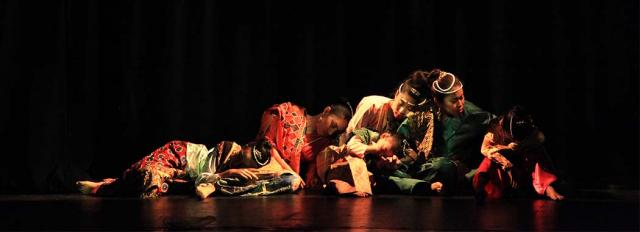
Tao Marayao (The Good Person) is a dance/movement piece about the Samal Balangingi, a maritime tribe from an island in the Southern Philippines. It’s part myth, part cultural history, presented through traditional Samal dance and narrative movement. Its story concerns the Spanish Conquest, from the arrival of the conquistadors to a sort of Samal diaspora in America. Tao Marayao is presented by La MaMa, in association with Kinding Sindaw, an organization with the mission of preserving indigenous Philippine culture. The show’s concept comes from Potri Ranka Manis Queano Nur (of Kinding Sindaw), who also directed and choreographed the show. The choreography ranges from stylization of real-life movement, as when the oarsmen row ships, to pure dance, as when the Samal women dance for visitors. The dance/movement is wonderful, graceful, a delight to watch. The barefoot dancers’ toe-out walk, their eloquent hand and finger gestures, their high-kneed walk are absolutely delicious. They generally move with calm, impassive faces, and at one point the performers sing in the Samal language. There are 18 dancers, including, happily, some children. The dancers’ work is complemented by gorgeous, traditional costumes (Flor Dechavez is credited as the costume seamstress). There are rich, sumptuous colors in the solids and prints, in the sashes, dresses, pants and headscarves. Some of the men wear painted bamboo hats. Sometimes the women’s hair is elaborated with strings of pearls (the Samal were expert pearl divers). There are pearls on their earrings and some wear exotic janggay, finger extensions. Four musicians in the show, forming a kulintang ensemble, play percussion instruments. The gandingan and the agung are types of gongs. The klutang is a wooden beam, and the kubing is a sort of jaw harp. Anklong are bamboo instruments that are shaken. The ensemble also play drums and a flute. The music is marvelous, haunting, and commanding by turns. We can follow the frame of the story through the performance alone. The Spanish arrive, with their armor and black beards, and are driven away. They return and kidnap the children. The Samal fight and overcome the Spanish, but the Spanish then overpower them. Finally, the Samal men end up in America, utterly degraded, as something like gladiators. “Savages” they’re called, who “fight to the death” for an audience. However, there’s more to the dance than the story, and we miss much of it because there’s no surtitles and no onstage narrator. It’s not clear what’s represented by what we’re watching. There are scenes from everyday life interspersed in the story, with the Samal working the fields and winnowing. And there are traditional tales as well, such as a tale of mermaids stealing pearls from a monkey. It’s lovely to watch, but inscrutable. Of course, it’s all explained in the program notes, but with 13 scenes in a 90-minute show, we can’t remember while we watch the performance what we read earlier. Nonetheless, Tao Marayao is marvelous. Its movement is the very picture of grace and elegance, and it’s danced superbly. We’re thankful that Kinding Sindaw is preserving this form of storytelling.
